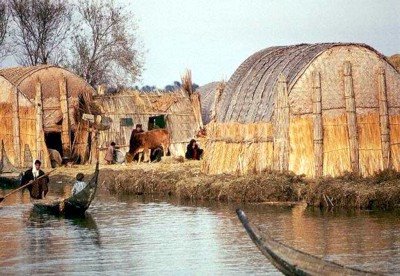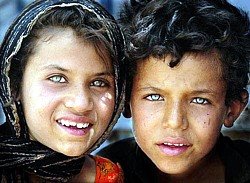Deteriorating situation prevents revival of marshlands

 Above: In better times, before the marshes were desertified by Saddam Hussein's diversion of the life-giving rivers. Left: two Marsh Arab children.
Above: In better times, before the marshes were desertified by Saddam Hussein's diversion of the life-giving rivers. Left: two Marsh Arab children.BAGHDAD, 3 October (IRIN) - Abdul-Jabar Muhsin, 34, is struggling to get his life back to normal in southern Iraq's once-lush marshlands, which were devastated by former president Saddam Hussein in the early 1990s.
"It is still too hard to get back to our normal life of breeding cattle and buffaloes, and planting and fishing," Muhsin said. He and his family were among thousands of Marsh Arabs forced to flee the lowlands of southern Iraq, also known as the Tigris-Euphrates alluvial salt marsh, in 1993.
The fabled marshlands were home to millions of native and migratory birds as well as Marsh Arabs, who had fished and grazed water buffalo in its waters for more than 5,000 years.
The 100,000 Marsh residents who have returned live in houses made of reeds and papyrus. Hygiene conditions are poor as they collect waste and sewage in holes underground, and then drain it into the marshes.
Muhsin said large chunks of the marshlands area in Basra, Maysan and Dhi Qar provinces were experiencing many difficulties, including lack of clean drinking water, sewage treatment and electricity. "The area had electricity during Saddam's era but now gets only about four hours' supply a day," he said.
The area's problems are compounded by lack of security, said Abdullah Ramadan, an official with the Marshlands revival centre in Basra. This has prevented government officials and international aid workers from following up on development projects in the marshlands.
These include a United Nations-sponsored project to help restore the marshes by providing clean drinking water and sanitation for the inhabitants.
The programme aims to provide villages with water treatment systems and to restore reed beds that act as natural water filters. It also will train 250 Iraqis in wetland management and restoration.
"There are signs of life returning to the marshlands," said Ramadan, adding that the region was still far from being as it was in the 1970s. "Of the almost 3,600 square miles of marshes in 1970, the area shrank by 90 percent to 300 square miles in 2002."
Ramadan said that about one-third of those forced to leave the area after the marshes were drained have now returned. But many have done so simply because the areas in central and northern Iraq where they have lived since the 1990s have become unsafe.
Read the rest at Reuters/Alternet
Related Link:
Iraq to regain control of another province in days
Related Link:
Marsh Arabs at Wikipedia

<< Home